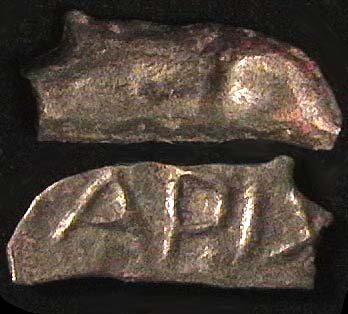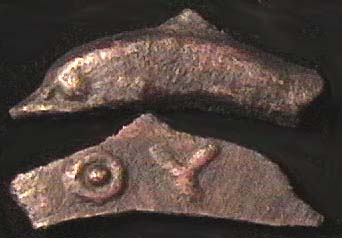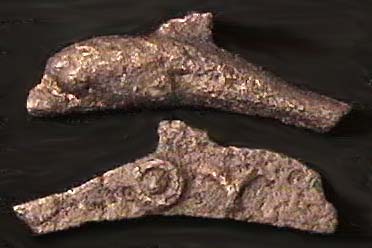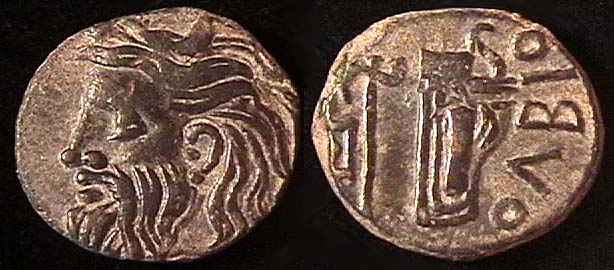 THRACE,
OLBIA, c. 300-200 BC, bronze dolphin,
cf. SG-1684, 25mm, nice eye on one side, F $55.00
sold 8/2/2012
THRACE,
OLBIA, c. 300-200 BC, bronze dolphin,
cf. SG-1684, 25mm, nice eye on one side, F $55.00
sold 8/2/2012
Click picture for enlargement.
 THRACE,
OLBIA, c. 300-200 BC, bronze dolphin,
cf. SG-1684, 25mm, nice eye on one side, F $55.00
sold 8/2/2012
THRACE,
OLBIA, c. 300-200 BC, bronze dolphin,
cf. SG-1684, 25mm, nice eye on one side, F $55.00
sold 8/2/2012
Click picture for enlargement.
 THRACE,
OLBIA, c. 300-200 BC, bronze dolphin,
cf. SG-1684, 26mm, similar but no eye, F $90.00
sold 1/9/2014
THRACE,
OLBIA, c. 300-200 BC, bronze dolphin,
cf. SG-1684, 26mm, similar but no eye, F $90.00
sold 1/9/2014
Click picture for enlargement.
 THRACE,
OLBIA, c. 300-200 BC, bronze dolphin,
Karshkovski-pl4
#7, API(X) on rev., 23mm, 2.5g, tiny chip off tip of beak & another
chip off the other side, the rest of it is VF $95.00
sold
THRACE,
OLBIA, c. 300-200 BC, bronze dolphin,
Karshkovski-pl4
#7, API(X) on rev., 23mm, 2.5g, tiny chip off tip of beak & another
chip off the other side, the rest of it is VF $95.00
sold
Click picture for enlargement.
 THRACE,
OLBIA, c. 300-200 BC, bronze dolphin,
Karshkovski-pl.4
#13, QY on rev., 23mm, 1.6mm, clear features,
decent surfaces, slight porosity, VF $118.00
sold
THRACE,
OLBIA, c. 300-200 BC, bronze dolphin,
Karshkovski-pl.4
#13, QY on rev., 23mm, 1.6mm, clear features,
decent surfaces, slight porosity, VF $118.00
sold
Click picture for enlargement.
 THRACE,
OLBIA, c. 300-200 BC, bronze dolphin,
Karshkovski-pl.4
#13, QY on rev., 24mm, 1.2g, nicer shape,
more porous, VF $110.00 sold
THRACE,
OLBIA, c. 300-200 BC, bronze dolphin,
Karshkovski-pl.4
#13, QY on rev., 24mm, 1.2g, nicer shape,
more porous, VF $110.00 sold
Click picture for enlargement.
Scroll to bottom of this page for
an article on the Olbian dolphins
They struck regular coins too:
 THRACE,
OLBIA, 3-1 c. BC, 24mm bronze, head of
river god Borysthenes L / axe & bow in case, SG-1685, choice XF
$61.00 sold
THRACE,
OLBIA, 3-1 c. BC, 24mm bronze, head of
river god Borysthenes L / axe & bow in case, SG-1685, choice XF
$61.00 sold
Click picture for enlargement.
AN ARTICLE ON THESE I WROTE FOR
COLLECTORS UNIVERSE.COM IN 2002
One of the more
unusual types issued during ancient times were the bronze dolphins of Olbia.
The Greeks were
a restless people, who liked to send out trading expeditions all over the
world, as far as they could go. If they liked what they saw in terms
of land and opportunities they had a tendency to stay and found colonies.
By the fifth century BC there were Greek settlements all around the Mediterranean
Sea and beyond.
North of Greece
proper lay Makedon, where Alexander the Great came from. The Makedonians
were heavily influenced by Greek culture, but were not Greek. North
of Makedonia lay the lands of the wild Thracians, who formed a barrier
to Greek expansion overland in that direction. No problem, the Greeks
would sail their boats through the Hellespont, the strait that separates
modern European and Asian Turkey, and they proceeded to trade and colonize
the coast of the Black Sea in what is now Bulgaria, and Ukraine.
By the fourth
century BC a number of Greek cities were thriving along the Black Sea coast.
Notable among them, at least from a numismatic standpoint, were Pantikapion,
Chersonessos, Istros, Mesembria, and Odessos, among others. These
cities issued more or less normal Greek style coins - silver staters and,
later, tetradrachms and fractions, and bronzes. The subject of this
article, situated not far from modern Odessa (not to be confused with ancient
Odessos), distinguished itself from the others by creating coins in the
shape of the badge of the city - the dolphin.
Olbian dolphins
were evidently made from the third to first centuries BC. Though
only one size (35mm - 1.37 inches) is shown in Sear's "Greek Coins and
their Values," Russian references show various sizes up to monsters a couple
of inches long. Almost all of them are crude. Very rarely one
shows up with a few letters on it, but most have no legend whatsoever.
These were rare
before the collapse of the Soviet Union. Now they are moderately
easy to find. Enough are on the market that people get picky about
them. They want them "with full tail." This is a little difficult,
because they were cast on trees, with the dolphins attached by their tails,
to be broken off as needed, and since this was the case, most of the time
the "tail" will simply mean that the back end of this piece is a little
longer than that one. There are anomalous pieces, however, that seem
to have been cast singly, and which have something that can legitimately
be described as a tail, and I guess these are the ones that everyone wants.
There also seem
to be two types of surface available - untouched-as-they-came-out-of-the-ground,
and nice black, smooth surface, the latter probably worked on by someone
in Ukraine.
Considering
the course of numismatic events, where things come on the market and disappear,
these little animal coins would seem to be things to grab while one can.
home
email
Bob Reis
POB 26303
Raleigh NC 27611USA
phone: (919) 787-0881
(8:30AM-10:30PM EST only please)
fax: (888) 503-8308
how to order